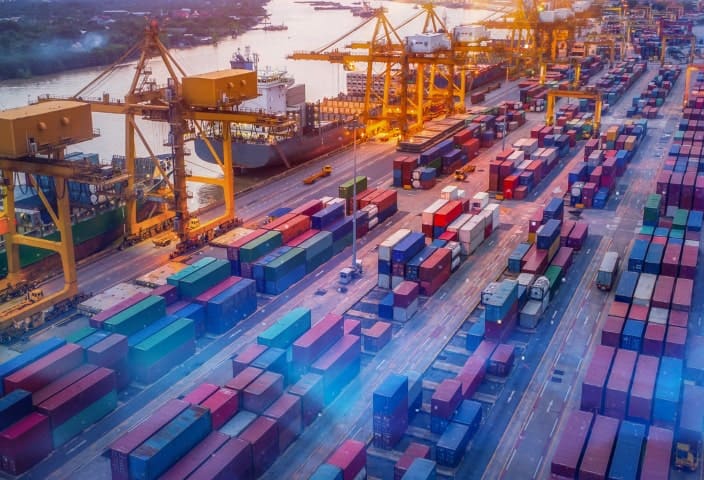Let's consider some supply chain challenges companies keep addressing in 2022 and ways to overcome them.
How to Make Your Supply Chain More Resilient
Over the past few years, global supply chains have been undergoing a never-ending crash test. The Suez Canal blocking, the worldwide lockdown caused by the COVID-19 pandemic, and geopolitical tensions are only a few events that have adversely affected and/or continue to affect supply chains. Each disruption causes financial losses, production delays, and customer loyalty reduction.
Richard Howells, an SAP supply chain expert, says the following:
“If companies have not addressed the increased risk across their supply chains at the start of the pandemic, they will again be seeing shortages of materials and products. The need is for resilient supply chains that address topics such as identifying alternate sourcing strategies to reduce dependencies on individual suppliers in low-cost regions.”
Let’s take a close look at what prevents businesses from building resilient digital supply chains today.

4 Supply Chain Challenges Companies Have to Address in 2022
These reasons or even one of them could significantly impact your business.
Data visibility
According to the World Economic Forum, only 9% of companies actively use software to collect data on all their business processes. At the same time, only 21% of managers are satisfied with the collected information quality and availability. Nevertheless, this is crucial information that helps companies effectively manage their supply chains.
However, such data is unlikely to be collected manually. What can help businesses? Modern technologies, such as the Internet of Things, artificial intelligence, and sound data and analytics management will provide companies with effective and, above all, timely decision-making.
Logistics disruptions
Despite its accelerated development, modern logistics continues to suffer from global disruptions, which are almost impossible to predict. Such disruptions create a ripple effect in global supply chains. Its result is warehouses full of goods and materials or, on the contrary, their shortage because their delivery slows down and may even stop altogether during such periods.
To avoid financial losses due to delays, downtime, and customer loyalty reduction, companies need to consider alternative supply chains, find storage options closer to their customers, and develop strategies for last-mile delivery and return of goods.
Reliance on third parties
Materials and goods delivery delays often arise from focusing on one large partner in the supply chain. This approach led to a sharp turnaround in prices businesses faced at the beginning of the COVID-19 pandemic. And it's the lack of alternative supply chains that caused it.
Global logistics disruptions have driven many companies to look for alternative trading partners and markets. However, there are also risks associated with the threat of counterfeit food and cybersecurity. To avoid them, businesses need to look for and select new providers of transport and logistics services.
Inventory optimization
Many companies use the just-in-time inventory model to avoid the expenses of transporting and storing goods. Its specialty is the delivery of goods only when consumer demand arises. However, this approach will fail during the next global supply chain disruption.
Some companies try to compensate for this approach’s shortcomings with the safety stock, but it can’t always meet the growing demand. Digital supply chains can help optimize your inventory. Their digitalization is especially relevant for constantly growing companies that work with more than one party.
Digital supply chains provide a centralized overview of all stocks, even if they are at the transportation stage. It allows you to make real-time adjustments to the supply chain and more accurately predict and allocate your stocks.
What Do Businesses Have to Change to Survive?
When any supply chain disruption occurs, rapid response is crucial for business. However, ensuring long-term supply chain sustainability has equal importance. Here are five steps to help you achieve this goal.
#1 Duplicate your most crucial supply chain stages
We are talking about their digital twins that allow you to simulate all the processes along the specific supply chain stage before its implementation. This approach helps you identify previously unknown suppliers and find new supply channels.
#2 Create “what if” scenarios
If you want to make any changes to your supply chains, test them with “what if” scripts to understand whether they help you achieve the desired result. “What if” scenarios help you try your ideas, as well as prioritize and mitigate disruptions results in your supply chains where they are most vulnerable to them. Such scenarios with different levels of detail need to be generated continuously to identify the vulnerability promptly.
#3 Share the data with your partners
Data transparency is the key to successful communication and effective collaboration with suppliers. This approach will help you optimize your supply chain, reduce transportation and warehousing costs, and ensure better decision-making even in critical situations.
#4 Diversify your supply chain network
To ensure your supply chain sustainability, collaborate with multiple suppliers. In this case, we are talking about different suppliers for the same products and various transport and logistics services in one specific region. It will help optimize your supply chain strategy and minimize delay and downtime risks.
#5 Use the right technology solutions
Hardly any operations that can make your supply chain more efficient and sustainable can be done manually. Or it may take too long, from several days to several weeks. By this time, much data will already become irrelevant.
SAP Digital Supply Chain (SAP DSC) covers all the logistics, manufacturing, planning, and operations needs. With this solution, you can:

Conclusion
The rock-solid truth is that global supply chains could never return to their pre-pandemic state. Disruptions caused by many local and global reasons will continue to put them under pressure. To be always ready for any market changes and disruptions, businesses must transform their supply chain strategy to adapt as fast as possible.
If you are ready to build efficient logistics processes, contact our experts. We assist you with choosing the right solutions.
How useful was this article?
Thanks for your feedback!


-min-1.jpg)
